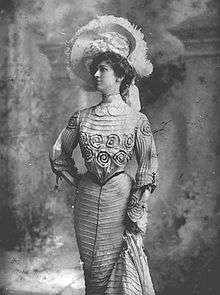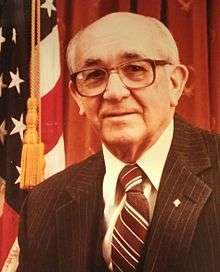Tennessee's 7th congressional district
| Tennessee's 7th congressional district | |
|---|---|
|
Tennessee's 7th congressional district - since January 3, 2013. | |
| Current Representative | Marsha Blackburn (R–Brentwood) |
| Population (2017 (estimate)) | 753,850 |
| Median income | 50,090 |
| Ethnicity |
|
| Cook PVI | R+20[1] |
The 7th Congressional District of Tennessee is a congressional district located in the middle and southwestern parts of the state, connecting suburbs of Nashville to rural areas east of Memphis.
Marsha Blackburn, a Republican and the first-ever Tennessee woman not to serve as a stand-in for her husband in Congress, assumed the 7th District's seat in 2003.
History
The district's current configuration dates from 1983, when Tennessee gained a district as a result of the 1980 Census. At that time, large portions of the old 6th District were shifted to the 4th and 9th districts, and the remaining territory of the old 6th was renumbered the 7th. Prior to the reapportionment that resulted from the 2000 Census, the district's boundaries generally coincided with county lines,[2] but in Middle Tennessee, the 7th district's geography resembled a gerrymander. The result was a district that was 200 miles long, but only two miles wide at some points in the Middle Tennessee portion--roughly the width of a highway lane. Redistricting after the 2010 census made the district somewhat more compact, restoring a configuration similar to the 1983-2003 lines.
The 7th is a very safe seat for the Republican Party. In fact, it has long been reckoned as the state's most Republican area outside the party's traditional heartland in East Tennessee. Democrats have made only two serious bids for the district since it took on its current form in 1983, and came within single digits only once. Most of the district's residents have not been represented by a Democrat since 1973. Even though the district lost its share of Memphis and eastern Shelby County, which had been part of the district and its predecessors since 1973, its conservative character remains unchanged.
The district's politics are dominated by the wealthy suburbs of Nashville, such as Brentwood, Franklin and Spring Hill. These areas boast some of the highest median incomes in the state, and have swelled with former Nashville residents since the late 1960s. They give the 7th a character similar to other highly affluent suburban districts in the South (e.g., those around Birmingham, Dallas-Fort Worth, San Antonio, Houston and Atlanta). Many of the state's most politically active churches are located in the suburban areas of the district, giving the 7th a strong social conservative bent typical of most affluent Southern suburban districts. Republicans dominate every level of government in the suburban areas, which tend to elect some of Tennessee's most conservative state legislators. The only area where Democrats compete on anything resembling an even basis is the largest city wholly in the district, Clarksville, which long elected Democrats to the state legislature.
The rural areas of the district are demographically similar to the rural portions of the 8th, and mostly sent Democrats to the General Assembly as late as 2010. However, most of the Democrats in the 7th's rural areas are as conservative on social issues as their suburban counterparts. They have long been more willing to support Republicans at the national level than their counterparts in the 8th. Many of the rural counties now in the district, for instance, voted overwhelmingly for George Wallace's (then governor of nearby Alabama) 1968 presidential candidacy, making Tennessee the strongest-performing state for him that he did not win.
The district has a very strong military presence, as it includes Tennessee's share of Fort Campbell.
List of representatives
| Name | Years' | Party | District Residence | Notes |
|---|---|---|---|---|
| District created March 4, 1823 | ||||
 Sam Houston Sam Houston |
March 4, 1823 - March 3, 1825 | Jacksonian D-R | Lebanon | |
| March 4, 1825 - March 3, 1827 | Jacksonian | Elected Governor of Tennessee | ||
 John Bell John Bell |
March 4, 1827 – March 3, 1835 | Jacksonian | Nashville | Appointed as U.S. Secretary of War |
| March 4, 1835 – March 3, 1837 | Anti-Jacksonian | |||
| March 4, 1837 – March 3, 1841 | Whig | |||
 Robert L. Caruthers Robert L. Caruthers |
March 4, 1841 – March 3, 1843 | Whig | Lebanon | Did not seek re-election |
| David W. Dickinson | March 4, 1843 – March 3, 1845 | Whig | Murfreesboro | Did not seek re-election |
 Meredith P. Gentry Meredith P. Gentry |
March 4, 1845 – March 3, 1853 | Whig | Franklin | Did not seek re-election |
| Robert M. Bugg | March 4, 1853 – March 3, 1855 | Whig | Giles County | Did not seek re-election |
| John V. Wright | March 4, 1855 – March 3, 1861 | Democratic | Purdy | Secession of Tennessee |
| American Civil War | ||||
 Isaac R. Hawkins Isaac R. Hawkins |
July 24, 1866 – March 3, 1867 | Unionist | Huntingdon | Did not seek re-election |
| March 4, 1867 – March 3, 1871 | Republican | |||
 Robert P. Caldwell Robert P. Caldwell |
March 4, 1871 – March 3, 1873 | Democratic | Trenton | Defeated for renomination |
 John Atkins John Atkins |
March 4, 1873 – March 3, 1875 | Democratic | Paris | Redistricted to 8th district |
 Washington C. Whitthorne Washington C. Whitthorne |
March 4, 1875 – March 3, 1883 | Democratic | Columbia | Redistricted from 6th district, Did not seek re-election |
.jpg) John G. Ballentine John G. Ballentine |
March 4, 1883 – March 3, 1887 | Democratic | Pulaski | Did not seek re-election |
 Washington C. Whitthorne Washington C. Whitthorne |
March 4, 1887– March 3, 1891 | Democratic | Columbia | Did not seek re-election |
.jpg) Nicholas N. Cox Nicholas N. Cox |
March 4, 1891 – March 3, 1901 | Democratic | Franklin | Did not seek re-election |
 Lemuel P. Padgett Lemuel P. Padgett |
March 4, 1901 – August 2, 1922 | Democratic | Columbia | Died |
| Vacant | August 2, 1922 – November 6, 1922 | |||
 Clarence W. Turner Clarence W. Turner |
November 7, 1922 – March 3, 1923 | Democratic | Waverly | Served remainder of term as caretaker |
 William C. Salmon William C. Salmon |
March 4, 1923 – March 3, 1925 | Democratic | Columbia | Did not seek re-election |
.jpg) Edward E. Eslick Edward E. Eslick |
March 4, 1925 – June 14, 1932 | Democratic | Pulaski | Died |
| Vacant | June 14, 1932 – August 12, 1932 | |||
 Willa Eslick Willa Eslick |
August 13, 1932 – March 3, 1933 | Democratic | Pulaski | Served remainder of term as caretaker |
 Gordon Browning Gordon Browning |
March 4, 1933 – January 3, 1935 | Democratic | Huntingdon | Redistricted from 8th district, Ran for U.S. Senate |
| Herron C. Pearson | January 3, 1935 – January 3, 1943 | Democratic | Jackson | Did not seek re-election |
| W. Wirt Courtney | January 3, 1943 – January 3, 1949 | Democratic | Franklin | Redistricted from 6th district, Defeated for renomination |
| James P. Sutton | January 3, 1949 – January 3, 1953 | Democratic | Wartrace | Redistricted to 6th district |
 Tom J. Murray Tom J. Murray |
January 3, 1953 – December 30, 1966 | Democratic | Jackson | Redistricted from 8th district, Defeated for renomination and resigned |
| Vacant | December 31, 1966 – January 2, 1967 | |||
 Ray Blanton Ray Blanton |
January 3, 1967– January 3, 1973 | Democratic | Adamsville | Ran for U.S. Senate |
 Ed Jones Ed Jones |
January 3, 1973 – January 3, 1983 | Democratic | Yorkville | Redistricted from 8th district, Redistricted to 8th district |
 Don Sundquist Don Sundquist |
January 3, 1983 – January 3, 1995 | Republican | Memphis | Redistricted from the 6th District, elected Governor |
 Ed Bryant Ed Bryant |
January 3, 1995 – January 3, 2003 | Republican | Henderson | Ran for U.S. Senate |
 Marsha Blackburn Marsha Blackburn |
January 3, 2003 – present | Republican | Brentwood | Incumbent |
Historical district boundaries

See also
References
- ↑ "Partisan Voting Index – Districts of the 115th Congress" (PDF). The Cook Political Report. April 7, 2017. Retrieved April 7, 2017.
- ↑ 106th Congress Congressional Districts in Tennessee Electronic Atlas
- Martis, Kenneth C. (1989). The Historical Atlas of Political Parties in the United States Congress. New York: Macmillan Publishing Company.
- Martis, Kenneth C. (1982). The Historical Atlas of United States Congressional Districts. New York: Macmillan Publishing Company.
- Congressional Biographical Directory of the United States 1774–present
Coordinates: 35°38′02″N 87°49′59″W / 35.63389°N 87.83306°W
.tif.png)